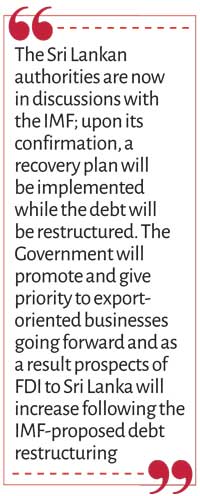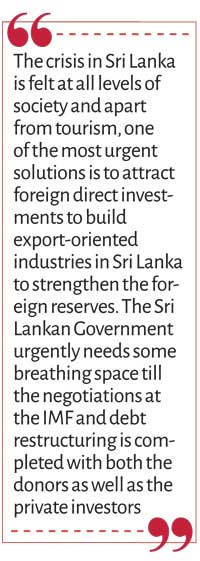Saturday Jan 17, 2026
Saturday Jan 17, 2026
Tuesday, 28 June 2022 01:00 - - {{hitsCtrl.values.hits}}

Once the US President John F. Kennedy said that when written in Chinese, the word ‘crisis’ is composed of two characters, one represents danger and the other represents opportunity. The Chinese phrase for “crisis” is “Wēijī:” 危机. Wēi, 危, does in fact mean danger, the word Ji (机), represents an incipient moment or crucial point when something begins or changes. Since it can be reinterpreted as, crisis time also is a time when things start to go awry. 
The crisis in Sri Lanka is also an opportunity for the country to bring forward an appropriate fiscal policy framework, vibrant leadership, investor-friendly policies, restructuring of the government sector, etc. The collapse of the Sri Lankan economy was gradually building up due to events in the past such as the civil war, socialist-centric economic policies, poor fiscal regulations, etc. However, the sudden downfall was due to a chain of recent events such as the Easter Sunday attack, COVID, and the Ukraine-Russian conflict, resulting in completely impacting the foreign currency coming in, especially from the tourism industry which annually brings over $ 5-6 billion; also, paying off the maturing ISB loans, global hike in fuel prices and the political instability brought the country to a deadlock.
The Sri Lankan authorities are now in discussions with the IMF; upon its confirmation, a recovery plan will be implemented while the debt will be restructured. The Government will promote and give priority to export-oriented businesses going forward and as a result prospects of FDI to Sri Lanka will increase following the IMF-proposed debt restructuring. Below is a layout of five projects to look out for:
1. The New Fortress Energy
The New Fortress Energy Inc. is a global energy infrastructure company listed on the New York Stock Exchange. The company accelerates the world toward the transition to clean energy and is known globally for expanding LNG infrastructure under Build, Operate, and Transfer agreements. In 2021 New Fortress Energy was interested in expanding its business in Sri Lanka and proposed to build the first offshore US liquefied natural gas (LNG) export facility and have it running in 12 months. However, due to complications the project was postponed but the interest in this project is still valid as the US LNG producers are working near peer capacity to supply buyers seeking alternatives to Russian gas over the crisis of Ukraine. 
Moreover, shortages of gas and demand for LNG have pushed global prices to new heights and spurred interest in new projects and countries such as India, Pakistan, Bangladesh, etc. are emerging markets with a lot of interest in expanding their national energy needs which are connected directly to three deepwater ports in Sri Lanka.
The agreement which was signed by the New Fortress Energy and the Sri Lanka Government in September 2021, focuses on building a terminal near Colombo. It also highlighted that the proposed LNG terminal will introduce LNG as an alternative source of cleaner energy in a quest to push Sri Lanka towards energy transition. As part of the agreement New Fortress will be given gas supply rights to the Kerawalapitiya Power Complex and will initially provide the Government with an estimated 1.2 million gallons per day of LNG. This will supply both the currently operational 310 MW Yugadanavi and an additional 350 MW at the Yugadanavi Power Plant to start operations from LNG by 2023.
2. Trincomalee Harbour and the Kurunegala-Trincomalee Expressway
Over generations, the harbour in Trincomalee was written in many books and publications for its strategic position, geographical formation of the natural submarine canyons, and most importantly the depth of the harbour. The harbour expands to an area of 1,630 hectares in water with a 500-metre-wide entrance making it one of the finest harbours in the world.
The two Panamax harbours in Sri Lanka, the Colombo Harbour which is known as a transhipment hub and is usually very busy and the Hambantota harbour in the south is developing to be linked to the industrial zone and has less military capabilities as the harbour is cut into the coast to avoid the heavy swells from annual monsoons, and its narrow channel makes the harbour useless for any military operation which gives less interest for global superpowers. However, the Trincomalee Harbour is ideally suited for a military base, yet it’s more likely that it will be developed as an energy harbour.
The current geopolitical interest in Asia puts the Indian Ocean as a strategic gateway, it is most likely that the US and its allies will engage in expanding its interest towards Trincomalee, and introducing LNG by the New Fortress could be the initial framework. 
However, ultimately the New Fortress Energy could expand its interest to Trincomalee port, which was mostly under the influence of India since 1987, yet the current global dynamics in the Indian Ocean are changing and India is now getting coupled with US businesses. The best example, the recent recoupling of the India-US business council under the US Chamber which is one of the world’s largest business organisations headed by the US Ambassador Atul Keshap, will eventually build more momentum for US business to establish in the region making Sri Lanka an important market for FDIs.
The inland infrastructure is very vital for improving investments and adding value, and linking the city of Trincomalee to the nation’s highway system would be something the investors and the Government might look into. The current expressway network to Kurunegala is proposed to be extended to Dambulla and to Trincomalee, in order to get all three deep sea ports into one network. The Bay of Bengal will then link to the Arabian Sea via land base corridor, changing global maritime routes forever and creating a lot of investment opportunities for Sri Lanka.
3. The Colombo Port City land lease
The Colombo Port City is one of the major investments in the Indian Ocean which is followed by many investors globally. Since the completion of the land reclamation, the project company identified 74 land plots, out of which 31 were completed in the technical proceedings. Six plots out of 31 will be released to the market first on a 99-year lease basis which can generate up to a $ 600 million investment commitment. As per the agreement between Urban Development Authority, CHEC Port City, and the Megapolis and Western Development Ministry, 286 acres out of a total of 440 acres of the liveable area will be leased to the CHEC Port City on a 99-year lease by the Sri Lankan Government.
Currently, the port city identifies the ‘Port City Villa Development’ in the land plot of 2-01-01 along with the Board of Investment Sri Lanka in an area of 27 acres with a minimum investment of around $ 400 million. The project also allows foreign investors many benefits including 100% ownership of real estate investments.
CHEC Port City has already signed a memorandum of understanding (MoU) with the Sri Lankan Government to develop a $ 1 billion worth building complex at Colombo International Financial Centre which will be established within the Port City premises.
So far, the construction work of a state-of-the-art duty-free shopping mall inside the Port City has already been started by two international companies which will draw another $ 2 billion for the building complex. The US-based Skidmore Owings & Merrill (SOM) was awarded the design contract to do the master plan of the design of the building.
The Sri Lankan Government approved the proposal to call for proposals to build a hotel, convention centre, hospital, and an international school on the State-owned land plots of Colombo Port City. The CHEC Port City has invested $ 1.4 billion in land reclamation and infrastructure development of the Colombo Port City project which will be an important investment project. In the midst of the crisis the Colombo Port City has been sailing smoothly meeting all the timelines and building the required soft and hard infrastructure.
4. Hambantota Industrial Zone
The Port Industrial Park holds around 600 acres of dedicated land, which is made available for the setup of businesses and industries. Having the Hambantota Port declared as a free port eases financial burdens in today’s fast-moving day and age for shippers and manufacturers to manage their cargo movement on import, export, and re-export. The Port Industrial Park follows and replicates the success of China Merchants Port’s strategic ‘PPC’ or Port, Park & City model, which was first effectively implemented in the renowned industrial zone – Shekou in Shenzhen, in China. This model has enabled investors to benefit from considerable savings in cost and time as a result of having the port within close proximity to their manufacturing plant
The industrial park has demarcated and classified three industry clusters, such as Heavy Industries, Light Industries, and Food processing Industries. The main aim of the Hambantota Industrial Zone is to set up any manufacturing industry that’s geared towards exports. Sri Lanka in the midst of two giant economies, India and China, holds strategic importance in mediating the future growth of the region.
So far, this vibrant development is made to attract investments and in 2020 November the Hambantota International Port Group signed a $ 300 million agreement with China’s Shandong Haohua Tire to manufacture tyres inside the Hambantota Industrial Zone, and is completing ground levelling to start construction, which also aims to employ local labour force and purchase locally sourced rubber. Also, another $ 16 million investment from China’s Shenzhen Xinji Group to set up a plug-and-play “Park in Park” facility in the Port Industrial Park. Shenzhen which is known as China’s Silicon Valley globally is known as a leading city in China and a technology hub, and through this investment, the company aims to transfer skills and technology and begin the production of household electric and electronic appliances.
In 2020 August the Hambantota Industrial Zone sealed another investment of $ 58 million with Sea Horse Yachts to assemble and export yachts. Sea House Yachts is a Maldivian company that expects to grow around 200 jobs and to make Sri Lanka a pioneer in the boat building industry.
The newly built Lanwa Sanstha Cement factory is adjacent to the Port Industrial Park and is able to discharge bulk raw materials for the Lanwa Sanstha Cement Factory via belts, and pipelines, and recently installed two cranes to move clinker, gypsum, and slag cargoes from vassals to the factory. The Hambantota-based Lanwa Sanstha Cement factory is able to enter the market with 2.3 million tonnes of capacity making it the largest cement factory in Sri Lanka. Moreover, under the Board of Investment Sri Lanka, another 400-acre land is established as the ‘Pharma Zone’ for investments in the production and exports of locally produced pharmaceuticals
5. The Colombo Light Rail
The Colombo light railway system is a long-due project in Colombo. Chinese firm Seoyoung Engineering undertook the feasibility study for the project in November 2017 and submitted it to the Sri Lankan Government in June 2018. However, the project was given the green light by the Sri Lankan Government to carry out with the support of the Japan International Government Corporation Agency (JICA) which is the official government agency for international projects. JICA also agree to offer $ 1.8 billion from the Japanese government under a 40-year repayment term and a 12-year grace period.
Construction of the first phase of the project is estimated to cost $ 2.2 billion and was scheduled to start in 2020. Commercial operations are expected to start by 2025. However, in 2019 the new government decided to halt the project. The light rail system will include 16 stations at IT Park, Malabe, Thalahena, Lumbini Temple, the National Hospital, Borella, Cotta Road, Rajagiriya, Welikada, Sethsiripaya, Battaramulla, Palanthuna, Robert Gunawardana, Colombo Fort, the transport centre and St. Joseph’s College. The estimated traveling time between Malabe and Colombo Fort was expected to be reduced to 30 minutes from the current 45-90 minutes.
Observations
The crisis in Sri Lanka is felt at all levels of society and apart from tourism, one of the most urgent solutions is to attract foreign direct investments to build export-oriented industries in Sri Lanka to strengthen the foreign reserves. The Sri Lankan Government urgently needs some breathing space till the negotiations at the IMF and debt restructuring is completed with both the donors as well as the private investors.
These projects can build some momentum to urgently improve foreign reserves and boost investor confidence. Moreover, when moving forward the current free trade agreements which Sri Lanka ratified as the South Asian Free Trade Agreement (SAFTA), the Asia-Pacific Trade Agreement, and bilateral Free Trade Agreements with India, Pakistan, and Singapore should be taken into consideration when identifying investments and expanding exports.
The ongoing negotiations of the Sri Lanka-China Free Trade Agreement could also be an important milestone to maximise Sri Lankan exports to the world’s fastest-growing and second-largest economy.
(The writer is an independent researcher on maritime affairs and BRI development. He graduated from Dalian Maritime University, and in 2016 was awarded by the Chinese Government a scholarship to complete a Master’s program in Environment and Natural Resources Protection Law at Ocean University of China. He is the co-founder of Belt and Road Initiative Sri Lanka (BRISL), an independent and pioneering Sri Lankan-led organisation, with strong expertise in BRI advice and support. He can be reached via e-mail: [email protected].)